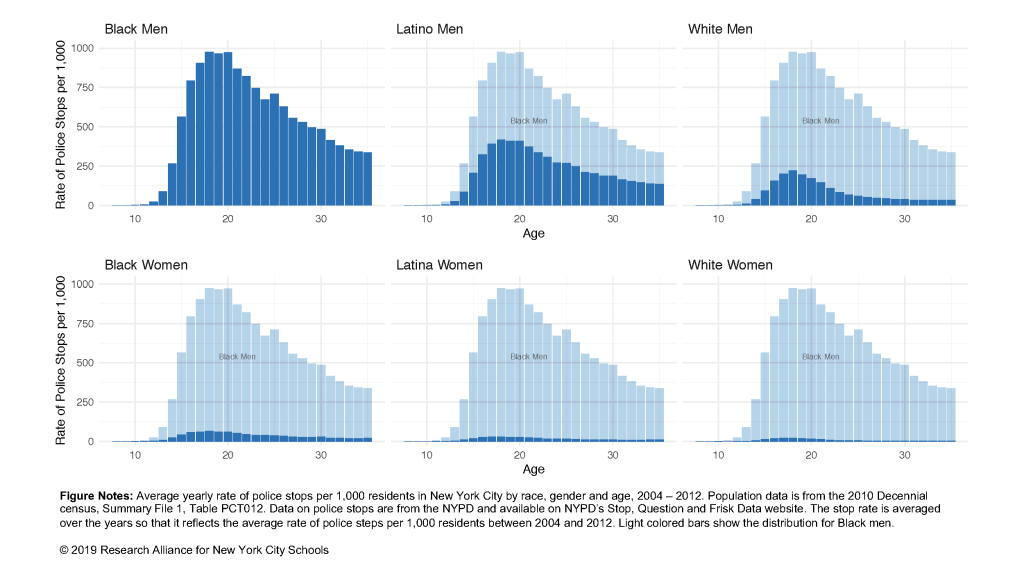Over the last few decades, cities across the United States have adopted proactive or broken windows policing strategies.[1] As a consequence of these changes, an increasing number of minority youth are in contact with the criminal justice system.[2] In New York City, the police conducted more than 4 million pedestrian stops between 2004 and 2012, with more than half concentrated among persons younger than 25 years of age.[3]
The figures below—based on our article in the journal Socius—show the rate of police stops per 1,000 residents by race, gender, and age for children and young adults in New York City between 2004 and 2012.[4] The figures combine data from the stop, question and frisk policing program in New York City with population data from the 2010 Decennial census.[5] The stop rate is averaged over the years so that it reflects the average rate of police stops per 1,000 residents between 2004 and 2012. The first figure shows the stop rates for Black males between the ages of 6 and 35. The other figures highlight this same information for Latino and White men and for Latina, White and Black women—in each of these figures, light colored bars show the rates for Black men as a point of comparison.
The figures reveal stark disparities in police exposure among school-aged children and young adults in New York City. For Black men as young as 15, the rate of police stops is 564 per 1,000 residents. By age 18, this rate is as high as 976 per 1,000 Black men. Other groups, however, experience substantially lower stop rates. At age 15, Black males are stopped 2.7 times more than their Latino counterparts and 5.9 times more than their White counterparts. Across the board, young women are stopped less frequently than young men. However, racial disparities persist: Black females are stopped 2.2 times more than Latina women and 3.3 times more than White women. With the presence of law enforcement in NYC schools, this high level of police exposure is not confined to students’ neighborhoods.

Disparities in police exposure raise important questions, with implications for policy and practice, some of which we highlight below.
Big Questions
- What are the consequences of high levels of police contact for the educational outcomes of students of color? Does a heavy police presence in students’ communities reduce violent crime and thereby increase educational opportunities? Or does policing negatively impact educational outcomes (e.g., by undermining trust in institutions and authority figures, or by creating stress and other health responses)? My recent study with Jeffrey Fagan sheds some light on these questions (Legewie and Fagan 2019). Focusing on NYC’s Operation Impact, we found that aggressive, hot-spot policing can reduce crime but also lowers test scores for older Black boys. For more information, see the full article here.[6]
- What are the implications of these findings for schools and education policymakers? How can educators address the potential negative impact of aggressive policing and provide stronger support, particularly for Black male students? Our policy brief draws on other Research Alliance work to suggest some potential responses.
What else should we be asking about police exposure among school-aged young in NYC? Are you exploring any of these topics? Let us know via email.
This post was authored by Joscha Legewie of Harvard University.
Footnotes
[1] Weisburd, David and Malay Majmundar. 2018. Proactive Policing: Effects on Crime and Communities. Washington, DC: The National Academy Press.
[2] Geller, Amanda. 2018. “Policing America’s Children: Police Contact Among Teens in Fragile Families.”
[3] New York Civil Liberties Union, 2018. Fagan, Jeffrey, Anthony A. Braga, Rod K. Brunson, and April Pattavina. 2016. “Stops and Stares: Street Stops, Surveillance, and Race in the New Policing.” Fordham Urban Law Journal 43:621–696. See also: Neil, Roland and Christopher Winship. 2019. “Methodological Challenges and Opportunities in Testing for Racial Discrimination in Policing.” Annual Review of Criminology 2(1).
[4] Figures, Kalisha Dessources and Joscha Legewie. 2019. “Visualizing Police Exposure by Race, Gender` and Age in New York City.” Socius . First Published February 26, 2019.
[5] Summary File 1, Table PCT012.
[6] Legewie, Joscha and Jeffrey Fagan. 2019. “Aggressive Policing and the Educational Performance of Minority Youth.” American Sociological Review 84(2).
How to Cite this Spotlight
Legewie, J. 2019. "Police Exposure Among School-Aged Youth in New York City." Spotlight on NYC Schools. Research Alliance for New York City Schools.

